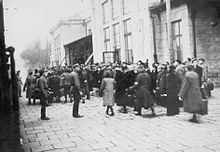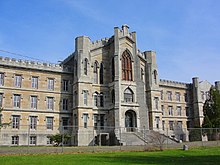Art Spiegelman
Jump to navigation
Jump to search
Art Spiegelman (/ˈspiːɡəlmən/; born Itzhak Avraham ben Zeev Spiegelman on February 15, 1948) is an American cartoonist, editor, and comics advocate best known for his graphic novel Maus. His work as co-editor on the comics magazines Arcade and Raw has been influential, and from 1992 he spent a decade as contributing artist for The New Yorker. He is married to designer and editor Françoise Mouly and is the father of writer Nadja Spiegelman.
Spiegelman began his career with the Topps bubblegum card company in the mid-1960s, which was his main financial support for two decades; there he co-created parodic series such as Wacky Packages in the 1960s and the Garbage Pail Kids in the 1980s. He gained prominence in the underground comix scene in the 1970s with short, experimental, and often autobiographical work. A selection of these strips appeared in the collection Breakdowns in 1977, after which Spiegelman turned focus to the book-length Maus, about his relationship with his father, a Holocaust survivor. The postmodern book depicts Germans as cats, Jews as mice, and ethnic Poles as pigs, and took 13 years to create until its completion in 1991. It won a special Pulitzer Prize in 1992 and has gained a reputation as a pivotal work, responsible for bringing scholarly attention to the comics medium.
Spiegelman and Mouly edited eleven issues of Raw from 1980 to 1991. The oversized comics and graphics magazine helped introduce talents who became prominent in alternative comics, such as Charles Burns, Chris Ware, and Ben Katchor, and introduced several foreign cartoonists to the English-speaking comics world. Beginning in the 1990s, the couple worked for The New Yorker, which Spiegelman left to work on In the Shadow of No Towers (2004), about his reaction to the September 11 attacks in New York in 2001.
Spiegelman advocates for greater comics literacy. As an editor, a teacher at the School of Visual Arts in New York City, and a lecturer, Spiegelman has promoted better understanding of comics and has mentored younger cartoonists.
| Art Spiegelman | |
|---|---|

Art Spiegelman in 2007
| |
| Born | Itzhak Avraham ben Zeev Spiegelman[1] February 15, 1948 Stockholm, Sweden |
| Nationality | American |
| Area(s) | Cartoonist, Editor |
Notable works
| |
| Spouse(s) | Françoise Mouly |
| Children |
|
Spiegelman began his career with the Topps bubblegum card company in the mid-1960s, which was his main financial support for two decades; there he co-created parodic series such as Wacky Packages in the 1960s and the Garbage Pail Kids in the 1980s. He gained prominence in the underground comix scene in the 1970s with short, experimental, and often autobiographical work. A selection of these strips appeared in the collection Breakdowns in 1977, after which Spiegelman turned focus to the book-length Maus, about his relationship with his father, a Holocaust survivor. The postmodern book depicts Germans as cats, Jews as mice, and ethnic Poles as pigs, and took 13 years to create until its completion in 1991. It won a special Pulitzer Prize in 1992 and has gained a reputation as a pivotal work, responsible for bringing scholarly attention to the comics medium.
Spiegelman and Mouly edited eleven issues of Raw from 1980 to 1991. The oversized comics and graphics magazine helped introduce talents who became prominent in alternative comics, such as Charles Burns, Chris Ware, and Ben Katchor, and introduced several foreign cartoonists to the English-speaking comics world. Beginning in the 1990s, the couple worked for The New Yorker, which Spiegelman left to work on In the Shadow of No Towers (2004), about his reaction to the September 11 attacks in New York in 2001.
Spiegelman advocates for greater comics literacy. As an editor, a teacher at the School of Visual Arts in New York City, and a lecturer, Spiegelman has promoted better understanding of comics and has mentored younger cartoonists.
Contents
Family history
Liquidation at the Sosnowiec Ghetto in occupied Poland during World War II; Spiegelman tells of his parents' survival in Maus.
In 1937, the Spiegelmans had one other son, Rysio (spelled "Richieu" in Maus), who died before Art was born[1] at the age of five or six.[5] During the Holocaust, Spiegelman's parents sent Rysio to stay with an aunt with whom they believed he would be safe. In 1943, the aunt poisoned herself, along with Rysio and two other young family members in her care, so that the Nazis could not take them to the extermination camps. After the war, the Spiegelmans, unable to accept that Rysio was dead, searched orphanages all over Europe in the hope of finding him. Spiegelman talked of having a sort of sibling rivalry with his "ghost brother"—he felt unable to compete with an "ideal" brother who "never threw tantrums or got in any kind of trouble".[6] Of 85 Spiegelman relatives alive at the beginning of World War II, only 13 are known to have survived the Holocaust.[7]
Life and career
Early life
Spiegelman graduated from the High School of Art and Design in 1965.
After he graduated in 1965, Spiegelman's parents urged him to pursue the financial security of a career such as dentistry, but he chose instead to enroll at Harpur College to study art and philosophy. While there, he got a freelance art job at Topps, which provided him with an income for the next two decades.[12]
After Spiegelman's release from Binghamton State Mental Hospital, his mother committed suicide.
Spiegelman began selling self-published underground comix on street corners in 1966. He had cartoons published in underground publications such as the East Village Other and traveled to San Francisco for a few months in 1967, where the underground comix scene was just beginning to burgeon.[15]
In late winter 1968 Spiegelman suffered a brief but intense nervous breakdown,[16] which cut his university studies short.[15] He has said that at the time he was taking LSD with great frequency.[16] He spent a month in Binghamton State Mental Hospital, and shortly after he got out his mother committed suicide following the death of her only surviving brother.[17]



Comments
Post a Comment